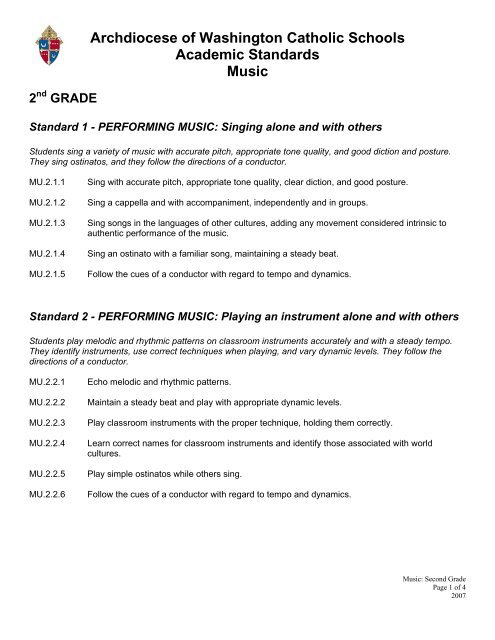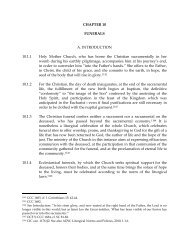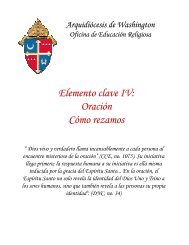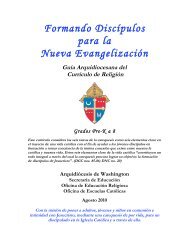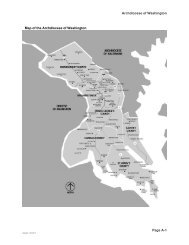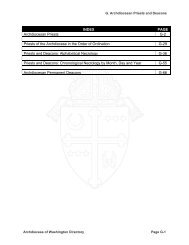Music - Archdiocese of Washington
Music - Archdiocese of Washington
Music - Archdiocese of Washington
You also want an ePaper? Increase the reach of your titles
YUMPU automatically turns print PDFs into web optimized ePapers that Google loves.
2 nd GRADE<strong>Archdiocese</strong> <strong>of</strong> <strong>Washington</strong> Catholic SchoolsAcademic Standards<strong>Music</strong>Standard 1 - PERFORMING MUSIC: Singing alone and with othersStudents sing a variety <strong>of</strong> music with accurate pitch, appropriate tone quality, and good diction and posture.They sing ostinatos, and they follow the directions <strong>of</strong> a conductor.MU.2.1.1MU.2.1.2MU.2.1.3MU.2.1.4MU.2.1.5Sing with accurate pitch, appropriate tone quality, clear diction, and good posture.Sing a cappella and with accompaniment, independently and in groups.Sing songs in the languages <strong>of</strong> other cultures, adding any movement considered intrinsic toauthentic performance <strong>of</strong> the music.Sing an ostinato with a familiar song, maintaining a steady beat.Follow the cues <strong>of</strong> a conductor with regard to tempo and dynamics.Standard 2 - PERFORMING MUSIC: Playing an instrument alone and with othersStudents play melodic and rhythmic patterns on classroom instruments accurately and with a steady tempo.They identify instruments, use correct techniques when playing, and vary dynamic levels. They follow thedirections <strong>of</strong> a conductor.MU.2.2.1MU.2.2.2MU.2.2.3MU.2.2.4MU.2.2.5MU.2.2.6Echo melodic and rhythmic patterns.Maintain a steady beat and play with appropriate dynamic levels.Play classroom instruments with the proper technique, holding them correctly.Learn correct names for classroom instruments and identify those associated with worldcultures.Play simple ostinatos while others sing.Follow the cues <strong>of</strong> a conductor with regard to tempo and dynamics.<strong>Music</strong>: Second GradePage 1 <strong>of</strong> 42007
<strong>Archdiocese</strong> <strong>of</strong> <strong>Washington</strong> Catholic SchoolsAcademic Standards<strong>Music</strong>Standard 3 - CREATING MUSIC: Improvising melodies, variations, andaccompanimentsStudents sing, play instruments, and use movement to improvise musical phrases including questions,responses, and ostinatos.MU.2.3.1MU.2.3.2MU.2.3.3MU.2.3.4Improvise a short melodic phrase on a pitched classroom or keyboard instrument.Sing short questions to be answered by classmates.Respond to teacher or student questions by singing and using body percussion, movement,found items, instruments, or electronic sounds.Improvise a short ostinato with a familiar song using body percussion, instruments, ormovement.Standard 4 - CREATING MUSIC: Composing and arranging music withinspecified guidelinesStudents create short rhythmic and melodic patterns within specified guidelines and create groupcompositions. They notate their music.MU.2.4.1MU.2.4.2MU.2.4.3Perform short rhythmic and melodic phrases within teacher guidelines and write them usingstandard or original notation.Create music collaboratively to enhance a poem or short story using a variety <strong>of</strong> sound sources.Arrange and perform a short sound piece cooperatively in small groups using the voice, bodypercussion, found items, or classroom instruments.Standard 5 - RESPONDING TO MUSIC: Reading, notating, and interpreting musicStudents read, write, and perform simple rhythmic and melodic patterns using standard or iconic notation andutilizing relevant examples from repertoire. They identify and interpret basic terms and symbols for dynamicsand tempo.MU.2.5.1Read and perform quarter, eighth, half, dotted half, and sixteenth notes, and quarter and halfrests in four-beat groupings using rhythm syllables.<strong>Music</strong>: Second GradePage 2 <strong>of</strong> 42007
<strong>Archdiocese</strong> <strong>of</strong> <strong>Washington</strong> Catholic SchoolsAcademic Standards<strong>Music</strong>MU.2.5.2MU.2.5.3MU.2.5.4MU.2.5.5Notate quarter, eighth, half, dotted half, and sixteenth notes, and quarter and half rests usingiconic or standard notation.Read pitch patterns from a staff and perform using solfège and hand signs.Identify direction <strong>of</strong> notated pitch patterns and interpret through singing, playing, or movement.Identify basic musical terms and symbols and interpret through singing, playing, or movement.Standard 6 - RESPONDING TO MUSIC: Listening to, analyzing, and describingmusicStudents identify similarities and differences in music using movement and musical terms. They recognizegroups <strong>of</strong> classroom and orchestral instruments. They identify and demonstrate appropriate listening behavior.MU.2.6.1MU.2.6.2MU.2.6.3MU.2.6.4MU.2.6.5MU.2.6.6Identify contrasts and changes in tempo and dynamics using basic music terminology andmovement.Identify repetition and contrast in sections <strong>of</strong> music using symbols or movement.Identify groups <strong>of</strong> classroom instruments by sight and sound.Identify families <strong>of</strong> orchestral instruments by sight and sound.Identify voices as those <strong>of</strong> children, adult males, or adult females.Discuss and demonstrate appropriate listening behavior for various types <strong>of</strong> performances.Standard 7 - RESPONDING TO MUSIC: Evaluating music and musicperformancesStudents discuss personal musical preferences. They compare contrasting musical works and establish criteriafor performances.MU.2.7.1MU.2.7.2MU.2.7.3Discuss personal preferences for different musical works.Listen to and compare two contrasting styles <strong>of</strong> composition using basic musical terminology.Establish and apply criteria for good musical performance in and outside the classroom.<strong>Music</strong>: Second GradePage 3 <strong>of</strong> 42007
<strong>Archdiocese</strong> <strong>of</strong> <strong>Washington</strong> Catholic SchoolsAcademic Standards<strong>Music</strong>Standard 8 - RESPONDING TO MUSIC: Understanding relationships betweenmusic, the other arts, and disciplines outside the artsStudents discover application <strong>of</strong> musical concepts in other disciplines. They express aural musical examples innon-musical ways and specific emotions through music and other means.MU.2.8.1MU.2.8.2MU.2.8.3Identify musical concepts such as tone color, repetition, and contrast, and ways they are used inother disciplines.Describe an aural musical example through movement, art, or writing.Express a specific emotion through music, art, movement, and writing or speaking.Standard 9 - RESPONDING TO MUSIC: Understanding music in relation tohistory and cultureStudents identify music for special occasions and its role. They experience music and dances from variouscultures and historical periods and explore roles <strong>of</strong> community musicians.MU.2.9.1MU.2.9.2MU.2.9.3MU.2.9.4Discuss suitable music for various special occasions and the role it plays.Discover the role <strong>of</strong> music from earlier periods in history such as the music <strong>of</strong> Native Americansand its relationship to other elements in the society.Perform and listen to music and learn folk dances from past and present cultures.Discuss roles <strong>of</strong> musicians in the community.<strong>Music</strong>: Second GradePage 4 <strong>of</strong> 42007


